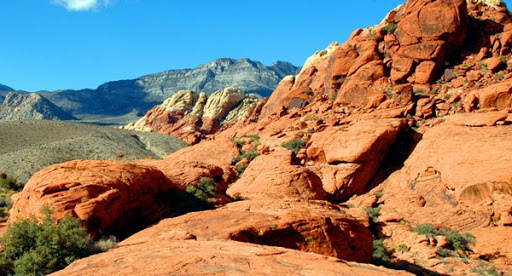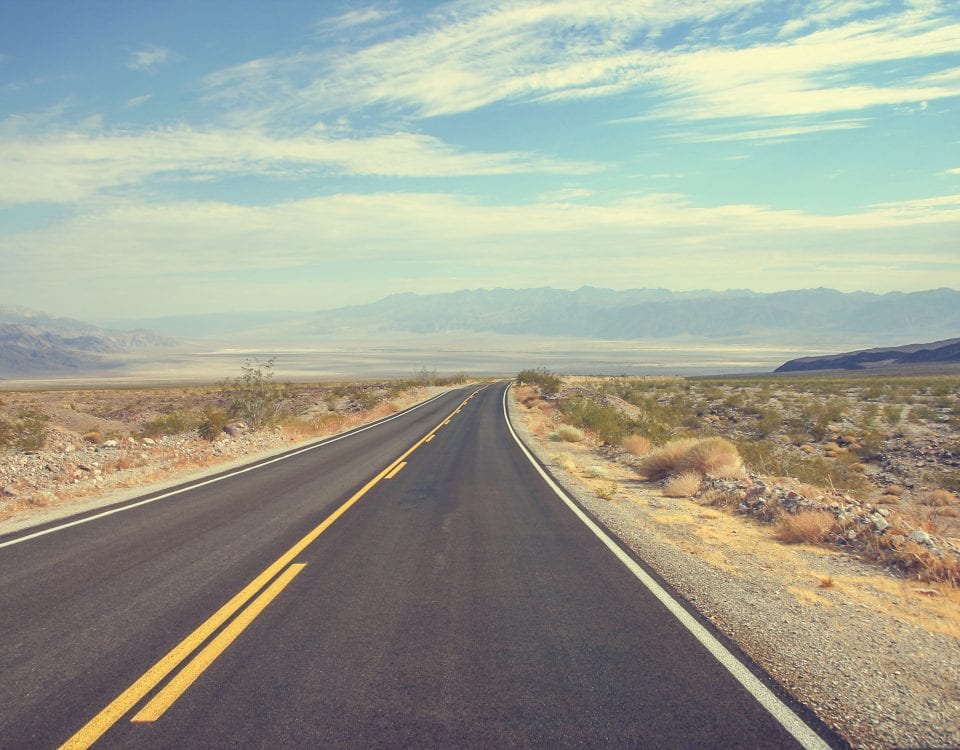
Day 53: Wandering Through Wyoming
May 11, 2021
Day 51: Entering the Wild West
May 9, 2021Most recently updated on February 22, 2024
Originally posted on May 10, 2021
Beer. Red Rocks. A magical Main Street. Some Old West history.
Day 52 has it all and more.
We begin today’s journey by traveling due south of downtown Denver for a half-hour until we reach the suburb of Littleton.
This town of 43,000 people is a community with a median annual household income of $90,000 and where the average home costs $660,000.
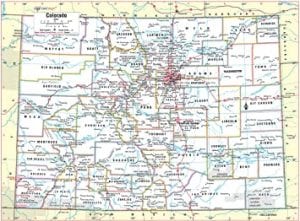
Its history isn’t overly dramatic. It’s named after its original settler, Richard Sullivan Little. The town has morphed from an agriculture community to a manufacturing center with an emphasis of aerospace.
You probably don’t know the town that well, but you most certainly have heard of its high school.
Columbine.
On April 20, 1999, the suburban community was in the glare of the national spotlight. That was the day that Columbine High School was the target of a mass shooting that killed 15 people, including 12 students, a teacher and two gunmen. Another 21 people were injured.
The killings began at 11:19 a.m. when the two teen gunmen, both students at Columbine High, began shooting students outside the school. They then moved inside to the library and shot more of their classmates. The spree ended at noon when the two gunmen shot themselves. At the time, Columbine was the worst mass school shooting in U.S. history.
A lot has happened in the aftermath of the massacre.
The shooting started a national debate on safety at school campuses with some schools establishing zero tolerance policies on disruptive behavior and violence.
The man who sold a gun to one of the teen assailants and then bought him 100 rounds of ammunition was sentenced to six years in prison. Another man who introduced the shooter to the gun seller was also sentenced to prison.
In 2001, there was a $2.5 million settlement with three dozen Columbine High families against the gunmen’s parents and gun suppliers.
In 2002, a $1.5 million settlement was reached between the Jefferson County’s Sheriff’s office and the daughter of the teacher killed.
In 2003, the families of five students killed reached an undisclosed settlement against the gunmen’s parents.
The Columbine Memorial was established in 2007 in Clement Park. The memorial includes an oval stone Wall of Healing and a grove of trees
There had been some discussion in 2019 of tearing down Columbine High and building a new school on the same site with the same name, mascot and school colors. However, a month after that proposal was unveiled, the school board shelved it.
———————————————
From Littleton, we head northwest to a more tranquil scene.

The Red Rocks Amphitheater outside Denver, Colorado. Photo by the Greeley Tribune.
A half-hour away is the Red Rocks Park and Amphitheatre. The park is 738 acres and sits where the geographic transition from the Great Plains to the Rocky Mountains is fully under way.
The park includes the Trading Post Trail, a 1.4-mile trail that weaves through red buttes at 6,200 feet elevation. There’s also a 9,500-seat outdoor amphitheater where the Beatles, Tom Petty and John Denver have performed. Theater officials say it’s only naturally occurring acoustically perfect amphitheater in the world.
The Visitors Center, opened in 2003, contains the Red Rocks Hall of Fame that spotlights some of the performers who have played at the amphitheater.
The city of Denver purchased the park in 1927. The amphitheater was built in the 1930s and officially opened in 1941. It was designated as a National Historic Landmark in 2015.
The group, Friends of Red Rocks, was formed in 1999. The organization’s stated goal is “preserve and celebrate the magic” of the park.
The park is located 10 miles west of downtown Denver. It’s open daily from one hour before sunrise to one hour after sunset on non-show days.
—————————————–
After that breath of fresh air, it’s time to head north to take in a trio of other Rocky Mountain towns.
Just 15 minutes out of Red Rock we come upon the town of Golden, a community of nearly 20,000 people nestled along Clear Creek at an elevation of 5,674 feet in the mountains northwest of Denver.
You’ve probably heard Golden’s name mentioned in a beer commercial, but the town is also known as the birthplace of a popular colorful candy as well as a respected mining school.
The Ute, Arapaho and Cheyenne tribes lived in the region for centuries.
The town was founded in 1859 after gold was found in Clear Creek. The city was named after Tom Golden, an early settler. It was also the Colorado Territory capital. When Colorado became a state in 1876, Golden residents were upset that Denver was named the state capital.
Golden was known as the “last flat place” before entering the Rocky Mountains and became a supply center for miners headed west. The rich soil of the Clear Creek Valley allowed the agricultural industry to develop.
In later years, other industries such as coal mining and clay extraction developed. In the 1870s, the city was home to five smelters as well as flour mills and the Golden Paper Mill, the only paper mill west of Missouri. Other businesses included a cigar factory, a glass plant and a candy factory. The arrival of the Colorado Central Railroad helped fuel more industry.

The Coors brewery in Golden, Colorado. Photo by ActiveRain.
Golden is probably best known for being home to the main Coors Beer refinery. This is the largest single brewery facility in the world. It was founded in 1873 by German immigrants Adolph Coors and Jacob Schueler, who bought a Pilsner recipe from a Czech immigrant. Coors invested $2,000 in the company and Schueler invested $18,000. Coors bought out his partner in 1880. By 1900, the Coors brewery was producing 48,000 barrels of beer a year.
During the Prohibition era in the 1920s and early 1930s, the brewery produced malted milk, soda and near beer products. They sold their malted milk to the Mars company for their candy products. Coors also relied on the company’s porcelain industry to keep his business afloat. The porcelain company is still around, known as CoorsTek. When Prohibition ended in 1933, the Coors complex was one of only 750 breweries out of more than 1,500 that was still around.
In 1959, Coors became the first beer company to use an all-aluminum can. Now, it has the largest aluminum can producing plant in the world, known as Rocky Mountain Metal Container. In 1970, Coors invented the litter-free push tab can to replace the ring pull tab. Coors Light was introduced in 1978.
For most of its first century, Coors was distributed only in 11 Western states. Montana, Washington, Iowa, Missouri, Nebraska and Arkansas were added between 1976 and 1979. The 1977 film “Smokey and the Bandit” starring Burt Reynolds centered on an illegal shipment of Coors from Texas to Georgia. Nationwide distribution began in 1986.
In 1977, workers went on strike at the Golden brewery. The company replaced the employees and some of the picketers came back to work. The union was de-certified.
Labor boycotts have hurt Coors sales at various times. In the 1960s, Coors was accused by Mexican-Americans of racial discrimination and a boycott was launched. In 1975, Coors settled out of court by agreeing not to discriminate against racial minorities.
In 1977, Coors was accused of firing gay and lesbian employees. By 1993, the company was openly recruiting gay and lesbian employees. In 1995, it extended benefits to same-sex couples. Peter Coors defended the company policy in his 2004 run for the U.S. Senate, although he was personally against same sex marriage.
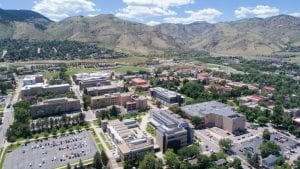
The Colorado School of Mines in Golden. Photo by U. S. News & World Report.
The company is known now as the Molson Coors Beverage Company after a Molson and Coors merger in 2005.
In August 2022, the company announced plans to redevelop 5 blocks of downtown Golden. Coors is closing its old manufacturing plant that produced pottery and other items and will use the 12-acre site to build homes, offices and retail outlets as well as a 150-room hotel and the global headquarters for CoorsTek. The 1.3 million square foot project will take 10 years to complete and cost $600 million. It will be known as Clayworks.
Golden is also the locale for the Colorado School of Mines, which offers engineering and science degrees with special expertise in development and stewardship of the Earth’s natural resources. The school was ranked in the 2016-2017 QS World University Rankings as the top institution in the world for mineral and mining engineering. The facility opened in 1873 under the auspices of the Episcopal Church to train engineers for the region’s mining industry. It’s been a state institution since 1874 and now has 7.600 students.
Every year, first-year students at the mining school are expected to climb up Mt. Zion with a 10-pound rock from their hometown and then whitewash the “M” on the mountain. The M was constructed by students and faculty in 1908. Lighting was installed there in 1931. The frosh climb back up as graduating seniors and retrieve their hometown rocks. Graduates receive diplomas etched on sterling silver.
The National Renewable Energy Lab is also here as well as the National Earthquake Information Center.
Golden is also the birthplace of Jolly Rancher candy. The company was founded in Golden in 1949 by Bill and Dorothy Harmsen as part of their Jolly Rancher Ice Cream Store in downtown Golden. The company is now owned by the Hershey Corporation, which moved operations from the Denver area to Mexico in 2002.
Finally, William “Buffalo Bill” Cody (1846-1917) is buried nearby on Lookout Mountain.
————————————————-
Our Wild West journey continues as we travel northbound on Highway 93 along the lower echelons of the Rocky Mountains.
In a half-hour, we arrive at the town of Boulder, a community of 108,000 that rests at an altitude of 5,344 feet. The median annual household income here is a healthy $99,000, but residents here might need every dollar of that salary. The median home price in Boulder is $960,000, nearly double the state average. Boulder is also ranked in one survey as the most expensive city in Colorado to live in.
One of those expensive homes here was in the news in 1996. The house on 15th Street in an upper-income neighborhood was where 6-year-old JonBenet Ramsey was murdered. There have been many suspicions about the killing, but no one has ever been brought to trial for the crime.
Boulder was also in the news in March 2021 when a gunman went inside the King Soopers grocery store and killed 10 people, including a police officer. The suspect in the mass shooting, Ahmad Alissa, is facing 115 felony charges. Court proceedings were delayed while mental health professionals determined if Alissa was competent to stand trial. The trial was finally given the go-ahead in fall 2023. In November 2023, Alissa pleaded not guilty by reason of insanity. A tentative trial date has been set for August 2024.
King Soopers reopened in February 2022, 11 months after the mass shooting. The store underwent a thorough redesign during that time.
Boulder has a long and interesting history.
The Southern Arapaho and other tribes inhabited the area as far back as 13,000 years ago.
The region was explored in the 1800s by Zebulon Pike, John Fremont and others. Gold prospecting brought people here in the 1850s. The town was founded in 1859.
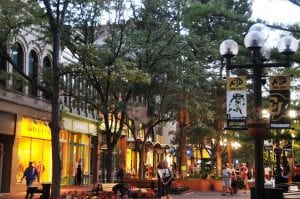
The Pearl Street Mall in Boulder, Colorado. Photo by Colorado.com.
By 1862, the local mines had yielded $100,000 worth of gold. Silver was discovered in 1869 and the town became a supply center for miners. The first railroads arrived in 1873 with a railroad depot being built in 1890.
The Colorado Chautauqua vacation resort was completed in 1898 as a place for Texas teachers to hold summer school in a cooler climate. The Boulder facility still offers educational and cultural programs. It is one of only three original Chautauqua Movement resorts left in the United States.
Boulder County adopted an anti-saloon ordinance in 1907. It was lifted in 1933. The city was “dry” until 1967, a bit ironic since it’s a half-hour from the world’s largest brewery.
To quench the city’s thirst, Boulder officials spent $200,000 to build a steel pipeline to bring crisp, clean mountain water from the Arapaho Glacier. Drinking fountains all over town had signs boasting about the “pure cold water” from the mountains. The last one of those publicly marked fountains is at the Hotel Boulderado.
In mid-1900s, companies such as IBM and Ball Aerospace opened facilities here as Boulder developed into a high-tech start-up mecca.
The city is also home to University of Colorado Boulder. The college opened in 1877 and now has 36,000 students, the largest in the state. The campus sits on 600 acres and hosts the Colorado Shakespeare Festival in the summer, an event that draws 20,000 spectators in a typical year.

The house used in the “Mork and Mindy” television series. Photo by Travel Boulder.
The student population helps make Boulder one of the more liberal cities in Colorado. It passed an ordinance in 1974 prohibiting discrimination based on sexual orientation. A 420 marijuana smoke-out was held in 2010 on the university campus with more than 8,000 participants. Police and local officials have since cracked down. in 2007, Boulder became the first U.S. city to levy a climate tax.
There are a lot of outdoor activities here. The city has 45,000 acres of parks and open space. Rock climbing is quite popular with Flatirons, a sharp-eyed rock walls on the city’s western edge being one of the busier locales. There are also a number of running and bicycle races in Boulder.
The Pearl Street Mall is a well-known four-block pedestrian mall with lots of shops and restaurants between 8th to 20th streets.
Celestial Seasonings operates out of Boulder. The facility was founded in 1969 by Mo Siegel. It now packages and sends out 8 million tea bags a day. There are 30-minute tours of the facility that include the Mint Room. The tours were halted for three years during the COVID-19 pandemic, but they returned in August 2023.
Boulder has its share of cultural landmarks.
The television show “Mork and Mindy” was based in Boulder. A 120-year-old home on Pine Street was used for exterior shots of Mindy’s house. The New York Deli in the Pearl Street Mall was also featured. The deli closed in 1999 and is now a sushi bar.
Stephen King lived here in 1974 and wrote “The Shining” after staying at the Stanley Hotel in Estes Park. King also used Boulder as the setting for “The Stand” where survivors of a super flu gather.
Boulder is also the place where the character Michael Scott moves with his fiancée at the end of season 7 of “The Office” television series.
—————————————
We have one final stop in Colorado on our journey today.
Fort Collins is a little more than an hour north of Boulder. The community of 169,000 is the fourth most populous city in Colorado. Like all the towns we’ve visited today, it sits at an elevation above 5,000 feet.
The Arapaho and other tribes initially lived in the region with one of the cottonwoods being considered a Council Tree.
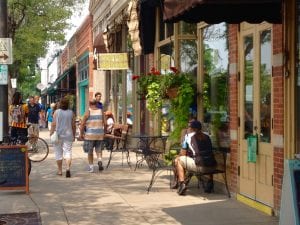
Downtown Fort Collins in Colorado was one of the inspirations for Main Street in Disneyland. Photo by the Downtown Fort Collins Creative District.
The first European settler arrived in 1860. Fort Collins was built as a military outpost in 1864 to protect the Overland Trail that ran from Kansas to Wyoming. The fort was decommissioned in 1867.
The town had a mill and brick yard open in 1872. The railroad arrived in 1877. The agriculture industry was established with sugar beets alongside sheep ranching. Stone quarries were also a chief industry. Great Western Sugar opened a processing facility in 1903.
An alcohol ban was in place here from 1896 to 1969 with bars and liquor stores operating just outside the city limits. Ironically, Fort Collins now has a large craft brewery industry. The economy today is a mix of manufacturing and service-related businesses. There’s also a high-tech component partly due to the presence of Colorado State University.
Fort Collins is also home to an obscure but potentially important radio station. WWV operates an array of radio towers just north of town behind security fences on pasture land and farms. The station’s radio signal reaches as far as Australia and New Zealand. Its remote location makes it an important component in the nation’s Military Auxiliary Radio System. Besides it’s everyday duties, the system is designed to be put to use in the case of a nuclear attack or other national emergency so military personnel can continue to communicate.
Fort Collins also has its place in the history of “The Happiest Place on Earth.” Along with Marceline, Missouri, Fort Collins was an inspiration for Main Street in Disneyland. Walt Disney spent 5 years of his childhood in Marceline. Harper Goff, one of the designers on the Disneyland project, grew up in Fort Collins. While sketching out Disneyland’s Main Street in the 1950s, both Disney and Goff reminisced about their childhood towns. The two men combined their nostalgic memories into what became the iconic street at the entrance of Disneyland.
Entering Wyoming
Out of Fort Collins, we zip north on Highway 287 on the high plateaus of northern Colorado.
In a half-hour, we cross over into Wyoming, a state of open spaces, high elevations and sparse populations.
Wyoming is the 10th largest state in acreage at 97,813 square miles. It also the least populated state with 586,000 people. Its most populous city has only 63,000 residents. Not surprisingly, Wyoming has the second lowest population density of any state at 6 people per square mile. Only Alaska is lower with an eye-popping 1 person per square mile.

Wyoming is a high altitude state. Its mean elevation is 6,700 feet, the second highest and only 100 feet behind Colorado. The western two-thirds of the state are the lofty ridges of the Rocky Mountains. The eastern third is part of the edges of the High Plains. Nearly half of the state’s land is owned by the federal government, including the Grand Tetons and Yellowstone Park. The vast majority of Wyoming’s land is classified as rural. Wyoming is also drier and windier than most states.
The first European explorer was John Colter in 1807 after he broke off from the Lewis and Clark expedition. Fur trappers came shortly afterward. Most of the region became part of the United States in the 1803 Louisiana Purchase. Southwestern Wyoming was part of the Spanish empire and then part of Mexico. It was ceded to the United States in 1848 after the Mexican-American War.
In 1850, Jim Bridger discovered Bridger Pass in the Rockies, a route used later by the railroads as well as Interstate 80. The population grew steadily after railroads reached Cheyenne in 1867.
In 1869, the Wyoming Territory granted women the right to vote, the first region of the United States to do so. It wasn’t all altruistic. Men outnumbered women 6 to 1 and territory leaders thought voting rights would encourage more women to come to the state. Women served on juries in Laramie in 1870. The state also had the first female court bailiff and the first female justice of the peace. Wyoming also elected the nation’s first female governor with the victory of Nellie Tayloe Ross in 1924. All these achievements led Wyoming to declare itself The Equality State.
The economy today is driven by mineral extraction. Wyoming is the leading coal producing state by far. However, that industry is fading as demand for coal decreases while renewable energy sources gain in popularity. The state is now producing about half as much coal as it did in 2008.
Wyoming is also the leading state in uranium production. That industry had dwindled in recent years, but experts are expecting a rebound in 2024 as demand and prices start to rise again.
Wyoming also extracts oil, natural gas and trona, a mineral used for manufacturing glass, soap, baking soda and pharmaceuticals. Wyoming has the world’s largest supply of this material.
Agricultural commodities include livestock, hay, sugar, wheat, barley and wool. Manufacturing is minimal in the state. Tourism brings in more than $3 billion in a typical year from the 10 million people who visit Wyoming in a typical year.
With its high altitudes and strong winds, Wyoming has enormous potential for wind energy. Right now, the state is not in the top 10 in wind energy production. However, over the past decade, companies have been laying the groundwork for wind-related projects in this high altitude state to take the place of the declining coal industry.
One of the bigger proposals is the Chokecherry and Sierra Madre Wind Energy Project, owned by the Power Company of Wyoming LLC. When completed, the facility will have 1,000 turbines capable of generating 3,500 megawatts of electricity, enough to power more than 1 million homes. Since Wyoming has less than 600,000 residents, they could export some of that electricity. Chokecherry has two phases with a total of 900 turbines. The $8 billion project is on the Overland Trail Ranch south of Rawlins, a town west of Laramie on Interstate 80. It’s expected to start generating electricity sometime in 2024. In June 2023, ground was broken on the TransWest Express transmission line that will carry electricity from Chokecherry to Southern California.
Three projects are on the drawing board near Medicine Bow, a small town north of Laramie. Combined, these new wind farms would produce 750 megawatts of power.
These proposals are welcomed by environmental groups opposed to Wyoming’s coal industry. However, rising construction costs may slow the development of these projects.
The jobs may be needed to keep younger adults from leaving Wyoming.
A report published in April 2021 by WyoFile detailed the exodus Wyoming is facing. The number of wage earners under the age of 24 declined by 30 percent in the state between 2008 and 2020. The millennial population here dipped by 5 percent between 2014 and 2018. The WyoFile article describes how many young Wyoming residents are faced with the dilemma of staying in a home state they love or moving elsewhere where there are more opportunities and more willingness for social change.
One program is trying to stem the tide. Officials at Wyoming Grown are trying to find jobs for educated Wyoming residents who have gone to other states. Among the incentives to try to lure these folks back is the average Wyoming commute is 18 minutes and the state has no income tax. The program promises to connect people who have a desire to return to Wyoming with career opportunities.
———————————-
A half-hour north of the Wyoming border is the town of Laramie.
This community of nearly 32,000 is the fourth most populous city in the state. It sits at an elevation of 7,165 feet. It’s the third highest altitude of any towns we visit in our 60-day journey. Only Los Alamos, New Mexico, at 7,300 feet and Santa Fe, New Mexico, at 7,198 feet, that we visited on Day 4 are loftier.
Native tribes lived in the region more than 10,000 years ago. The city is named after Jacques La Ramie, a French-Canadian trapper who was killed by tribe members in the nearby mountains about 1819. Laramie was founded in 1862 along the Overland Stage Trail. Fort Sanders was built in 1866.
The Union Pacific segment of the Transcontinental Railroad arrived in Laramie in 1868, prompting the rise of an “end of the tracks” tent city. Laramie suffered through a period of lawlessness, led by Deputy Marshal Steve Long who forced people to hand over deeds to property or be killed. Long and his two half-brothers were eventually lynched by law enforcement officers.
As part of the Wyoming Territory, Laramie was the first town in the world to have women serve as jurors. Louisa Swain, 70, became the first woman to cast a legal ballot in a general election in the United States during a municipal election in 1870.
In 1874, Union Pacific opened a rolling mill for reprocessing worn iron rails. It eventually employed 300 people. Other early businesses included a railroad tie treatment plant, a brick yard, a slaughterhouse, a brewery, a glass manufacturing plant and a plaster mill. Several regional railroads were also located here. In 1886, a plant to produce electricity was built. Cattle and sheep ranches also emerged as did a nearby stockyard.
Union Pacific was a dominant economic force for nearly a century. Railroad jobs declined after the 1950s with the introduction of the diesel engine. The economy today includes tourism, retail, cement manufacturing and health services.
The University of Wyoming is now the city’s largest employer with 3,000 workers. The university opened its doors in 1887 to 40 students. Today, the college has 12,000 students.
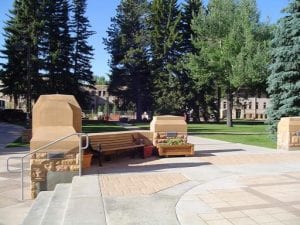
The Matthew Shepard memorial bench at the University of Wyoming in Laramie. Photo by Finding Brokeback.
Laramie was in the national spotlight in the late 1990s when Matthew Shepard, a gay student at the University of Wyoming, was murdered. Shepard, who was born in Casper, Wyoming, was 21 when he was robbed, beaten, tortured and left to die just outside Laramie on the night of October 6, 1998, by two men who lured him away from the Fireside Lounge. He was found the next morning by a bicyclist who at first thought Shepard’s limp body was a scarecrow. Shepard was taken to hospital in Fort Collins and died six days later from severe head trauma.
The two men were arrested and charged with first degree murder and kidnapping. Both were convicted and received life sentences.
The murder shocked the nation and prompted local, state and national leaders across the country to approve hate crime legislation. The new laws included the Matthew Shepherd and James Byrd, Jr., Hate Crimes Prevention Act that President Barack Obama signed in 2009.
In October 2018, Shepard’s parents placed their son’s ashes in a crypt inside the Washington National Cathedral. They hadn’t buried his ashes for 20 years because they feared his gravesite would be vandalized.
Judy and Dennis Shepard started the Matthew Shepard Foundation in 1998 to foster LGBT awareness and education. Judy Shepard has authored a book, “The Meaning of Matthew,” that discusses her son’s murder as well as the legal and social aftermath. There’s also a book of poetry called “October Mourning: A Song for Matthew Shepard.”
“The Laramie Project” was a play written in 2000 about Matthew Shepard’s murder. The play was made into a movie in 2002. A documentary called “Matthew Shepard is a Friend of Mine” was released in 2016. There is also a concert-length musical piece, “Considering Matthew Shepard,” that was dedicated several years ago.
Dennis Shepard told 60 Days USA in spring 2021 that the foundation started from money that was sent to the family while their son was in hospital to help pay for medical bills. They decided to pay the bills with their own funds and use the contributions for something else.
“We wanted to do something for Matt’s community,” Shepard explained.
The foundation became official on December 1, 1998 on what would have been Matthew Shepard’s 22nd birthday.
Dennis Shepard went back to his job in Saudi Arabia for 12 years to pay the family bills while Judy did most of the touring and speaking. Shepard said his wife was one of the first public figures to talk about bullying and not just against LGBT people but all marginalized communities.
“I’m really proud of what she accomplished,” he told 60 Days USA in spring 2021.
Shepard said the impact of his son’s death has had far-reaching effects. He said the murder was so egregious that it forced people to sit up and take notice. Matthew Shepard, he noted, was a 5-foot-2, 105-pound young man who loved fishing, camping, school, theater, people, politics and movies.
“Everybody could see something in themselves or somebody in their family or circle of friends in Matt,” said Shepard.
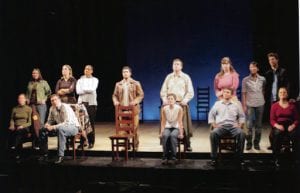
“The Laramie Project” was a play written in 2000 about Matthew Shepard’s murder. Photo by Paula Ries Costume Design.
Shepard said the murder had the biggest impact on the people who were in their teens and early 20s at the time. Many of these younger people are now in their 30s and 40s and are in important positions at their workplaces. That’s why, Shepard said, you see corporate initiatives that support the LGBT community as well as other groups.
“They have taken that indignation [about the murder] with them and carried it with them in their personal and professional lives,” he said.
Shepard said progress has been made since 1998. Awareness of the issues affecting LGBT people is higher and acceptance of the community is more common. He notes the 2009 hate crime bill was a big accomplishment. He also believes the movement after his son’s death helped pave the way for recognition of same-sex marriage and the elimination of the “don’t ask, don’t tell” policy in the U.S. military.
There is work still to be done. Shepard said changes in how hate crimes are reported, recorded and investigated need to be made. He also wants to see better job protections for LGBT people and urges the Senate to pass the Equality Act that was approved by the House in February 2021. As of February 2024, the Senate still hadn’t voted on the legislation.
Shepard is concerned about the rise in hateful attitudes he said he witnessed during the four years of the Trump administration.
“It has to do with all the nasty discourse by the haters because they were able to come out from underneath the rocks,” he said.
Nonetheless, Shepard is optimistic that progress will continue. He is buoyed by some of the steps the Biden administration has taken.
“I really believe this will come to fruition because we are starting to realize what a contribution the LGBT community makes,” he said.
Shepard urges everyone to think of LGBT people as decent, hard-working people who lead regular lives.
“They’re just trying to have a normal life,” he said. “They just want to have their careers and maybe a family and they just want to die at an old age with a smile on their face because they had a wonderful life.”
There is a bench dedicated to Matthew Shepard on the University of Wyoming campus. The bench is off South 12th Street near Prexy’s Pasture and the university’s student health center. It was dedicated in 2008.
There are other historical sites in Laramie as well for visitors to check out.
The Laramie Plains Museum was built in 1892 as the Ivinson Mansion. The family donated the home in 1921 to Episcopal Mission District of Wyoming. That group used it as a boarding school until 1958. The house was purchased by the Laramie Plains Museum Association in 1972. The 3-story museum displays the rooms in the house as they were lived in the late 1800s and early 1900s.
There’s also the Wyoming Women’s History House. The museum celebrates the suffrage movement in Wyoming. The exhibits honor 13 women pioneers, including Swain, Verda James, the first woman elected as speaker of the Wyoming House, and Lynne Cheney, author and wife of former vice president Dick Cheney. The museum is managed by the Louisa Swain Foundation.
Finally, there is an unusual truck stop 22 miles west of Laramie on Interstate 80. The Akal Travel Center provides gasoline, diesel fuel, snacks and other things you’d normally see at such a locale. What makes this truck stop special is its menu. The Akal center serves up Indian food, in particular Punjabi cuisine.
Mintu Pandher told CBS Sunday Morning in 2019 that he wanted to provide truckers barreling down the freeway something different and healthier to eat. Pandher said when truckers ask for a hamburger, he tells they can get that meal anytime on the road. He tells them to try his dishes. Most of them like the new taste on the lonely highway.
Pandher’s philosophy seems to be paying off. He has opened two more Akal Travel Centers in New Mexico and another one in Nebraska.
——————————–
We jump back on Interstate 80 east for our final segment of today’s virtual journey.
In less than an hour we arrive in Cheyenne. The state capital is the most populous city in Wyoming with 63,000 residents, 76 percent of whom are white and 16 percent of whom are Hispanic or Latino.
It’s slightly lower than Laramie in elevation at 6,089 feet. It also has had some remarkably healthy air over the years. A 2021 report from the American Lung Association listed Cheyenne, along with Casper, Wyoming, as having some of the cleanest air in the country when it comes to particle pollution. However, in April 2023, the lung association reported that Wyoming’s air quality in general and Cheyenne’s air quality specifically had worsen over the past two years.
Cheyenne was founded in 1867 by Gen. Grenville M. Dodge and his survey crew in what was then the Dakota Territory. The settlement was named after the Cheyenne tribe. It was chosen as the site where the Union Pacific Railroad would cross Crow Creek. The town grew quickly after it was designated as a supply depot for the railroad. It was nicknamed “The Magic City of the Plains.”
In 1867, Fort D. A. Russell was established three miles outside town to protect railroad workers from local tribes. The fort became a permanent Army installation in 1884 and was renamed after Francis E. Warren in 1930. In 1943, it housed 1,000 German and Italian prisoners of war. In 1947, it was designated as the F.E. Warren Air Force Base. In 1957, it housed the nation’s first operational ICBM unit with 24 Atlas missiles. The base still oversees 15 missile alert facilities and 150 Minuteman III missiles in parts of Wyoming, Nebraska and Colorado. F.F. Warren is the oldest continuously active Air Force base.
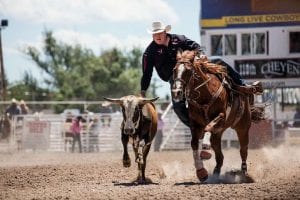
Cheyenne Frontier Days is the world’s largest outdoor rodeo. Photo by Picryl.
In 1875, Cheyenne became a supply center for miners after gold was discovered in the Black Hills. The town also became a distribution center for the state’s burgeoning cattle industry, so much so that wealthy ranchers built luxury homes in a section of town known as Millionaire’s Row.
Cheyenne Regional Airport was opened in 1920. The facility first served as a stop for air mail deliveries from Chicago to San Francisco. It shifted to passenger service beginning in the late 1920s. During World War Two, thousands of military aircraft, including B-17s and B-24s, were outfitted and upgraded there. The Cheyenne Modification Center employed as many as 1,600 workers. United Airlines operated a stewardess school here from 1947 to 1961. Larger planes such as the DC-4 eventually made it unnecessary to stop at Cheyenne on cross-country flights, so the airport is now a regional transportation facility that still serves the Wyoming Army National Guard.
The city’s economy today is centered on agriculture, cattle, sheep and transportation as well as state and federal government.
There is a definite western feel to the town.
Cheyenne Frontier Days is held over 10 days in late July. It’s the largest outdoor rodeo in the world and has been held annually since 1897. It draws 250,000 spectators in a typical year. The festival starts with the annual Walking of the Steers from pasture land to Frontier Park. The events include concerts and rodeo contests with $1 million in prize money.
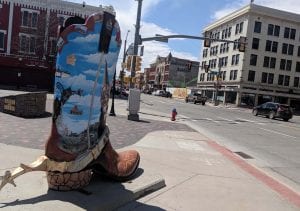
The Big Boots art project in downtown Cheyenne, Wyoming. Photo by The Monumentous.
You can also experience some western culture at the Cheyenne Frontier Days Old West Museum. The exhibits here center on early rodeos and artifacts such as 1800s passenger wagons.
There’s also the Cheyenne Depot Museum. The building was donated to the city by Union Pacific in 1993. The museum showcases the beginnings of Cheyenne during the construction of the Transcontinental Railroad.
Finally, there’s the Cheyenne Big Boots artist displays around town. Local business owners sponsored the painting of 24 of these 8-foot-high fiberglass boots in the downtown area by local artists in 2004. The project raised money for the Cheyenne Depot Museum. Some boots were auctioned off, but most remained scattered around the downtown area. New ones have been added to the collection over the years, so there’s now more than 35 boots.
Seems like a good junction to put up our feet.
Tomorrow we head north through Wyoming on our way to Montana. Along the route we’ll uncover the origins of the jackalope, check out a rock formation that became synonymous with a presidential scandal and visit a field that was the site of a famous last stand.

